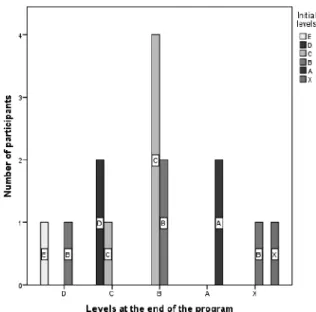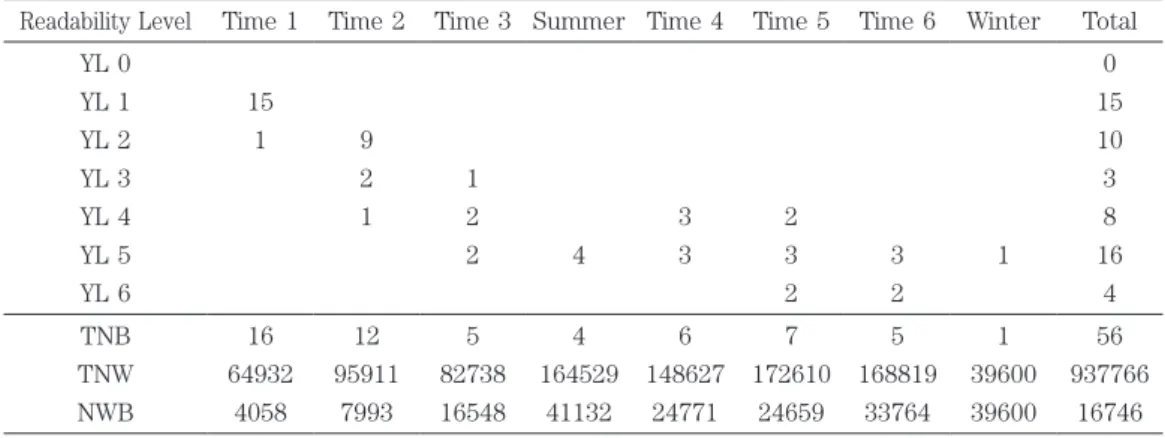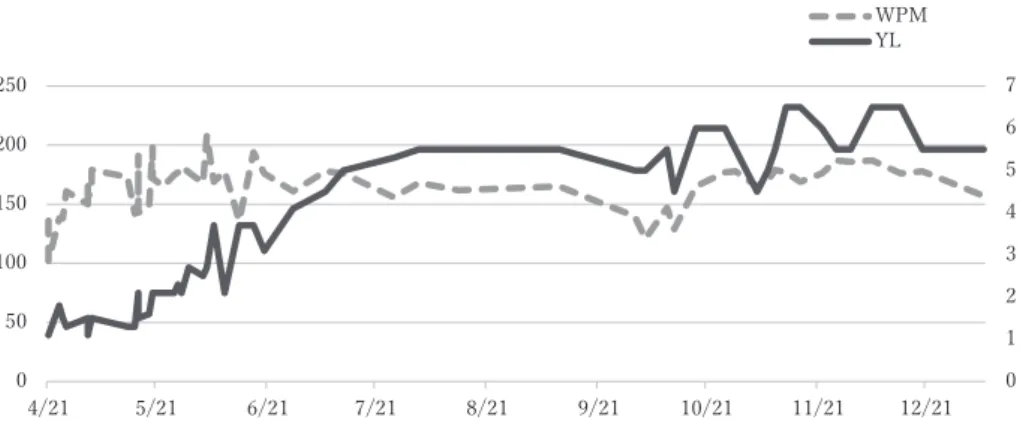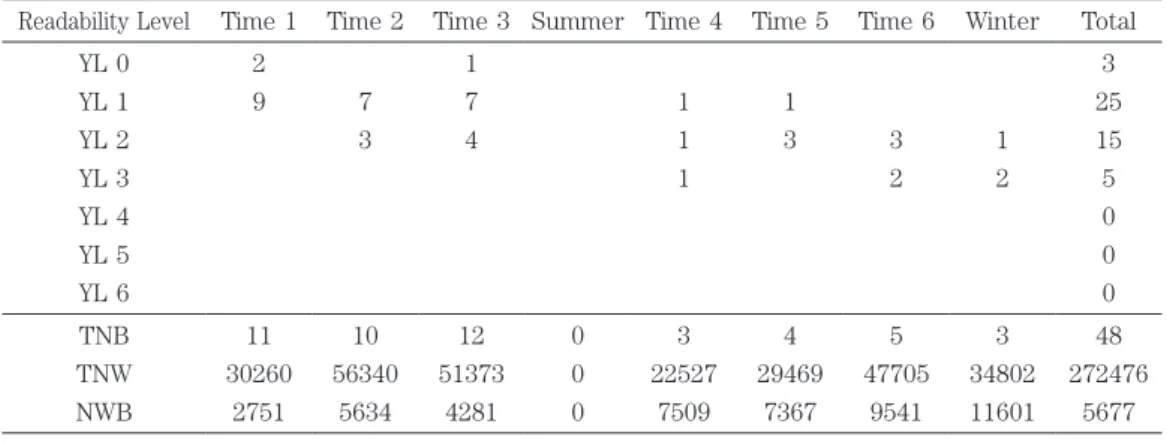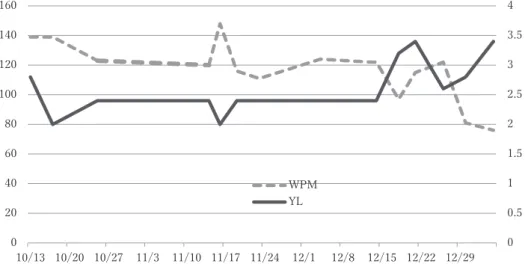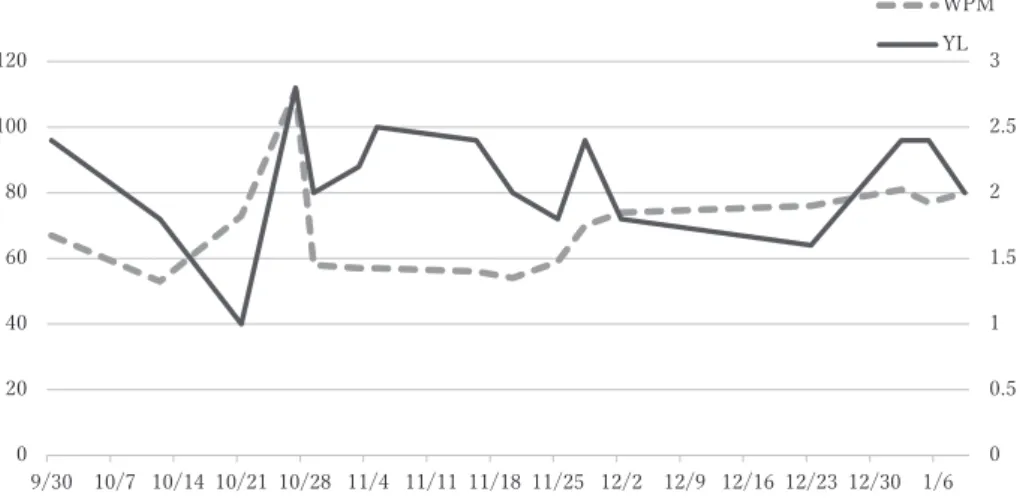Extensive Reading and Learner Agency: A Case Study
多読と学習者エージェンシー:ケース・スタディ
Kiyomi Yoshizawa
吉 澤 清 美
本研究は指定教科書を使う英語リーデイングの授業において、教科書のタスクに主な授業 時間をとり、多読を授業中に行う時間が非常に限られた学習環境で多読を一年間実践する中 で、流暢な読み方をしながら読み物の内容を理解する力を伸ばしていく学習者とそうではな い学習者の読書行動を比較・対照した。3 名の研究参加者の一年間の読書記録を多読本の読 みやすさの変化と読書量の観点から分析した結果、二つの傾向が浮かび上がった。流暢に読 む力を伸ばすためには読書量だけではなく、読書行動が重要であることが判明し、読書行動 は流暢な読みの発達に必要な認知的要因と学習者エージェンシーを反映していると考えられ る。 キーワードEnglish extensive reading, reading behaviors, reading comprehension processes,
learner agency 多読、読書行動、読解プロセス、学習者エージェンシー
1 Introduction
A fluent reader is capable to read extended texts for long periods of time “with reasonable comfort and without needing to stop constantly, and without feeling fatigued or overwhelmed” (Grabe, 2009, p. 311). Grabe says that “practice in extensive reading” (p. 312) leads to fluent reading. Day and Bamford (1998) describes ten characteristics “that are found in successful extensive reading programs” (p. 7). Four of those characteristics were listed below:
1. Students read as much as possible, perhaps in and definitely out of the classroom. 2. A variety of materials on a wide range of topics is available so as to encourage
reading for different reasons and in different ways.
3. Students select what they want to read and have the freedom to stop reading material that fails to interest them.
terms of vocabulary and grammar. Dictionaries are rarely used while reading because the constant stopping to look up words makes fluent reading difficult. (pp. 7-8) Many studies over the past 20 years have indicated the positive effects of extensive reading on both the cognitive and affective aspects of studying English such as learners’ language ability and motivation. Jeon and Day (2016) conducted a meta-analysis to examine the effectiveness of ER on reading proficiency (i.e., reading comprehension, reading rate, and vocabulary). They examined 49 primary studies published from 1980 to 2014, including only studies which had embodies the characteristics of ER described in Day and Bamford (2002, pp. 137-140). The meta-analysis results showed small to medium effect sizes. Jeon and Day further examined whether the effects of ER differed significantly due to moderator variables, including setting (i.e., English as a second language setting and English as a foreign language setting), age, library size, length of treatment, text type (i.e., web-based books vs. paper books), ER form, and focus skills. They found age, setting, text types, and ER forms led to different effects. Concerning the ER forms, Jeon and Day reported that ER as a part of curriculum showed the highest mean effect, followed by ER as an extracurricular activity, ER as a part of reading course, and ER as an independent reading course. However, the authors recommend to inter-pret the results about ER forms with caution. That is because the most common forms are ER as a part of curriculum or reading course and only one study was included for ER as an inde-pendent reading course or extracurricular activity, respectively.
Although the overall supremacy of extensive reading approach over traditional approaches to reading has been reported in Jeon and Day (2016), other studies not included in their meta-analysis address the issues in their own educational context. One of the issues is reading behaviors of participants in ER programs.
Nishizawa et al. (2011) and Nishizawa, Yoshioka, and Nagaoka (2017) examined the reading behaviors of reluctant learners of English who had extensive reading sessions in their school curriculum. Nishizawa et al. (2011) examined critical factors for a successful extensive reading program based on their nine-year practice of extensive reading with technology majors in Japan. Their participants were the learners at a national institute of technology (NIT) specialized in educating engineers in Japan. NITs accept junior high school graduates, who had three years of English education prior to the admission, and students have seven years of English education. Although English proficiency of NIT students is generally quite weak and their self-efficacy in learning English is generally not high, the researchers needed to decide the amount of reading and the readability levels of text for their students to read so that they could raise their English proficiency to the level needed at their future workplaces. Nishizawa et al state that two of the
critical factors for a successful ER program are the amount of reading and readability of English texts. Nishizawa et al. analyzed the students’ reading amounts and their TOEIC scores and found that the amount of reading is proportional to the increase of TOEIC scores. Then, the authors divided their students into seven groups according to the reading amount for two years and a half. The means of TOEIC scores increased as their reading amounts increased. Ninety-six percent of the students with low scores (e.g., TOEIC scores less than 300) read less than 400,000 words. As the students read more than 400,000 words, the number of students who scored less than 300 decreased and the average test scores increased. Further, Nishizawa et al point out that reading materials should be easy enough for students to process for meaning without translating into their L1 for meaning. This aspect is quite important for learners to find reading is not a mechanical drill translating L2 into L1 to understand, but to find reading is enjoyable and they can continue to read in L2.
Similarly, Nishizawa et al. (2017) examined the reading amount and readability levels of English text read by Japanese EFL learners who had extensive reading classes with traditional reading classes for two years and a half. The participants were engineering majors. The authors suggested that their students should read more than 600,000 words before their English profi-ciency can improve and that ER programs at their institution should have a longer duration than three years so that most students can read the target amount. They also examined reading logs of nine students and reported that the students who had read more easier books, i.e, graded readers with fewer than 300 head words, scored higher in an English proficiency test, but those who had read more difficult books, i.e., graded readers with 300 to 1000 headwords, scored lower. The authors suggested that their engineering students should read 200,000 words from the easy-to-read books whose Yomiyasusa Level (a readability scale for Japanese EFL learners, YL) is less than 1.1.
Also, Nishizawa et al. (2011) and Nishizawa et al. (2017) observed a group of learners who read more than the median number of words read by the other ER groups although the number of books read was much smaller than the median number of books read by the other ER groups. Those students were considered to have selected longer and more difficult books to read. The average score of those students on the TOEIC were much lower than other ER groups in their studies.
Nishizawa et al. (2011) and Nishizawa et al. (2017) are rare cases in terms of the duration of extensive reading. According to Jeon and Day (2016), long-term extensive reading programs are rare and the duration of most of the ER programs is one academic year or less (p. 261).
extensive reading programs at university levels is usually one academic year, if it is not shorter. After a one-year extensive reading program, their students can read about 100,000 words on average. However, they observed some learners increased the scores on a proficiency test at the end of a one-year ER program and others decreased the scores even though the reading amounts of the former students did not differ from those of the latter students. Mayuzumi and Miyatsu named the former “successful group” and latter “unsuccessful group.” They analyzed reading logs of 10% of learners in each group. The TOEIC tests were used as pre- and post-tests. First, they examined the number of words per book read by two groups each month. The successful group had a slight increase in the number of words per book as the year progressed. On the other hand, the unsuccessful group fluctuated the number of words per book with a falling tendency. Next, the authors analyzed the comments written by the students when they finished reading each book. The successful group commented on the content of the books and showed they were involved in what was written in each book. On the other hand, the comments written by the unsuccessful readers were much shorter and did not reflect the content of a book as much as the successful readers.
Mayuzumi and Miyatsu (2011) summarize the reading behaviors of the successful and unsuc-cessful readers. The former start to read books which they can comprehend and continue to read at a steady pace. Further, the successful group are engaged in reading and they enjoy the content of a book. On the other hand, the unsuccessful group start to read books whose read-ability levels are higher than their reading levels before reading easy-to-read books. Consequently, the comments written by the unsuccessful group do not reflect that they comprehended the content of a book.
Nishizawa et al. (2011), Nishizawa et al. (2017), and Mayuzumi and Miyatsu (2011) indicate that reading behaviors of the ER participants can determine whether learners in an ER program succeeds or not and their reading logs can be a valuable source which shows a learner’s reading behavior. The findings of these three studies provide important educational implications for ER practitioners. On the other hand, their studies practiced extensive reading one year or more at institutions where extensive reading is a part of curriculum or reading course. Reading exten-sively in and out of the class is a main task for the participants. However, it is not known how reading behaviors of the learners would affect their reading performance where extensive reading is practiced in addition to the tasks assigned from a required reading textbook. The current study is conducted to examine the reading behaviors of the EFL learners in the context where extensive reading is assigned in addition to tasks based on a reading textbook. The following two research questions were examined in the current study:
(1) What are the reading behaviors of the learners whose reading proficiency was improved after one-year extensive reading?
(2) What are the reading behaviors of the learners whose reading proficiency did not show any growth after one-year extensive reading?
2 Method
2.1 Context of the current study
The current study took place in an English as a foreign language context. The learners in the study were the first-year students majoring in foreign language studies at a four-year university. In the freshmen years, all the students were required to take language classes focusing on four language skills and two classes related to the study abroad (SA) program in addition to liberal arts classes. The participants of the current study were in a reading class focusing on developing their reading skills in the academic context. The class used a required textbook for 75 to 70 minutes each week. In their sophomore years, all the students in the program were required to study abroad for one year.
All the freshmen took TOEFL Institutional Testing Program at the beginning and at the end of the first year. The initial TOEFL scores were used for placement purposes. The results of the second TOEFL scores were used to confirm that the students’ English proficiency has reached the threshold level for some of the study-abroad programs. Consequently, students’ motivation for learning English is high in their freshmen year before they leave for a one-year SA program. 2.2 Selection of participants
Three Japanese university students participated in the study and they were in a reading class where 18 students were registered at the beginning of the year. Figure 1 shows the number of the students at each reading level at the onset and end of the reading class which incorporated extensive reading. The learners’ reading levels are based on a placement test called EPER_ppt, which is explained in the Method section. The letters in bars indicate the reading levels at the onset of the programs. Three students did not take the EPER_ppt at the end of the second semester, so their data is not available.
At the beginning of the first semester, one student was E, three Ds, five Cs, five Bs, and three As. Also, Figure 1 indicates there is one X, the highest level among the EPER levels. According to Day and Bamford (1998), the average vocabulary of E-level readers is 800; that of D-level readers is 1200; C-level readers, 1600; B-level readers, 1900; A-level readers, 2,200;
X-level readers, 3000. At the end of the year, there were two Ds, three Cs, six Bs, and three As. Two students were X. One student started from the second semester, so he did not have the EPER score at the beginning of the first semester. However, the EPER score at the beginning of the second semester showed that his level was B and his level at the end of the second semester was A. Among the participants who have test scores both at the beginning and end of the school year were examined further. In general, the students’ EPER levels improved by one to two levels. However, there were six students whose EPER levels stayed the same: one participant remained X; two, A; two, B; and one, C. The learners who improved their reading levels were considered successful readers; those who did not improve their reading levels were considered unsuccessful readers.
Three participants were selected from successful and unsuccessful readers, respectively, to examine their reading behaviors over the year. Sho (pseudo name) was considered a successful reader and Masa and Sachi (pseudo names) were unsuccessful readers. The starting levels of Sho and Masa were B and that of Sachi was C. At the end of the school year, Sho’s reading level was X; however, the EPER levels of Masa and Sachi remained the same.
2.3 How extensive reading was conducted
In the first week of the first semester, EPER_ppt was administered to assess the reading levels of the students in a reading class. In the second week, the students were explained about the purposes of extensive reading and specific instructions were provided about the starting levels and choice of books. A list of books which has 284 book titles was provided to each student. Those books are graded readers with readability (i.e., YL) ranging from YL 0.6 to 2.3. The rationale behind providing the book list is to encourage the learners not to read books too difficult for them, but to read relatively easy books in the first few weeks. Each book has the name of series, the number of running words, readability level. Also, each book has spaces for writing checkout dates, reading time, and short comments. After the ER orientation, the students checked out books for reading out of the classroom. From the third week to the thir-teenth week, the participants engaged in Sustained Silent Reading for approximately 15 minutes of the class time at the beginning of each class. After in-class reading, the participants checked out the books for the following week. Also, each time a student finished reading a book, he/she kept a reading log, including the date, title, series, level, word count, reading time, and a short comment. Students’ reading logs were collected monthly and checked for their progress. The participants were asked to submit the copies of their reading logs at the end of the semester. Further, each participant was asked to select one book and write a summary of a story and his/her opinion about the story.
Extensive reading was continued during the summer recess. In the 15th week of the first
semester, the participants were asked to continue extensive reading during the summer recess and they checked out books for summer reading. Also, students were required to select one book from their summer reading and submit a summary/opinion paper about the book. The same procedure was repeated in the second semester except that the ER orientation was not provided. 2.4 Materials
Edinburgh Project on Extensive Reading Placement/Progress Test (EPER_ppt). Edinburgh Project on Extensive Reading Placement/Progress Test (henceforth, EPER_ppt) is a 141-item cloze test developed by the Edinburgh Project on Extensive Reading (henceforth, EPER), a research and material development project “to promote a systematic use of graded readers within an extensive reading programme” (English Language Teaching Centre, The University of Edinburgh). Learners start with easy readers at the beginning stage and develop their abilities to read unsimplified text. To achieve its goal, the project classified all the graded readers published in the UK and some published in Europe and USA into eight levels of
diffi-culty (G, F, E, D, C, B, A, and X). G is an elementary level and X is an advanced level. The beginning reading level of a learner and his/her progress is determined by the result of the EPER_ppt. There are eight readability levels (EPER levels) developed by EPER “to provide a common scale on which to place books from various series and various publishers, and to permit the learner to make easy progress from level to level (Day and Bamford, 1998, p. 172).
Reading Logs. In order to answer the research questions, the participants’ reading logs were analyzed. Based on Mayuzumi and Miyatsu (2012), each participant’s reading log was analyzed in two aspects: how he/she read ER books throughout the year and the reading amounts. Further, reading rates were calculated for each participant to finish reading each book.
2.5 Procedure
At the beginning of the course, the EPER_ppt was administered as a pre-test in order to determine the participants’ English proficiency. The same test was administered at the end of the first semester as the mid-test, and at the end of the second semester as the post-test.
3 Results
3.1 Time periods
Three participants’ reading logs were analyzed to examine the reading behaviors of successful and unsuccessful readers. The academic year was divided into eight reading periods : three approximate one-month reading periods in the first semester (e.g., from the beginning of the school year to mid-May, from mid-May to mid-June, mid-June to mid-July), summer recess, three approximate one-month reading periods in the second semester, and winter recess (approximately two weeks in December and another two weeks in January). Each book a participant read in each reading period was recorded in terms of readability levels (i.e., YL levels), the number of books and the number of words read in each period, and the total number of books and words read over the year.
3.2 Sho
Table 1 shows the number of books, the number of words, and the number of words per book read by Sho in the year. The readability levels in Table 1 and the following tables indicate the readability levels expressed in Yomiyasusa Levels (henceforth, YL). YL is a subjective measurement created by ER practitioners who read both graded and leveled readers published by various publishers and assessed their readability levels. There are 10 levels and each level
has 10 sublevels. In the current study, YL 0 – YL 6 refer to the following: YL 0: YL < 1.0; YL 1: 1.0 =< YL < 2.0; YL 2: 2.0 =< YL < 3.0; YL 3: 3.0 =< YL < 4.0; YL 4: 4.0 =< YL < 5.0; YL 5: 5.0 =< YL < 6; YL 6: 6=< YL. That is, YL 0 refer to the books whose readability levels were smaller than 1.0. YL1 refers to the books whose readability level is equal to 1.0 or larger, but less than 2.0 and so forth. Figure 2 shows the readability levels (YL) of the ER books read by Sho in the academic year and the reading rate of each book. In Figure 2, the straight lines show the YLs and the dotted ones show reading rates in terms of words per minute (WPM).
The first characteristic of Sho’s reading is that he continued to read all the year. The second characteristic is that Sho read easy-to-read books at the onset of the program: he read 15 YL 1 books, 27% of the entire number of books, in Time 1. ER specialists recommend that Japanese EFL learners should read a sufficient amount of easy-to-read books for developing their reading proficiency (e.g., Nishizawa, Yoshioka, & Nagaoka, 2017; Takase, 2008). This point was explained to all the learners in class in the orientation session in the second week of the first semester. In Sho’s case, his easy-to-read books were YL1 books. The third characteristic of Sho’s reading behaviors is that he raised his YL levels incrementally. In Time 1, the average read-ability level of the books he read was 1.44, 2.5 in Time 2, 4.08 in Time 3, 5.5 in the summer recess, 5 in Time 4, 5.1 in Time 5, 6 in Time 6, and 5.5 in the winter. Although it seems that he raised his YL level rather abruptly from 2.7 to 3.7 on June 6, from 2.1 to 3.7 on June 13, and from 3.1 to 4.1 on June 28, a sudden change in YLs was rare in Sho. Further, his reading rates ranged from around 150 to 180 WPM over the year and the sudden changes in YL did not drop his reading rates.
Table 1 The number of books, the number of words, the number of words per book read by Sho Readability Level Time 1 Time 2 Time 3 Summer Time 4 Time 5 Time 6 Winter Total
YL 0 0 YL 1 15 15 YL 2 1 9 10 YL 3 2 1 3 YL 4 1 2 3 2 8 YL 5 2 4 3 3 3 1 16 YL 6 2 2 4 TNB 16 12 5 4 6 7 5 1 56 TNW 64932 95911 82738 164529 148627 172610 168819 39600 937766 NWB 4058 7993 16548 41132 24771 24659 33764 39600 16746
Note. YL = readability level of ER books; TNB = the total number of books; TNW = the total number of words;
3.3 Masa
Table 2 shows the number of books, the number of words, and the number of words per book read by Masa in the year. Figure 3 shows the YLs of the books read by Masa in the first semester; Figure 4 shows the changes of his reading rates added to Figure 3. Figure 5 shows the YLs and reading rates in the second semester. The first characteristic of Masa’s reading behaviors is that the readability levels of ER books were mainly YL1 and YL2. YL1 books and a half of YL2 books were read mostly in the first semester. The second characteristic of Masa’s reading behavior is that his YLs did not show incremental shifts in the readability levels of the ER books. In other words, he did not gradually raise his YLs. Masa read books ranging from YL 0.8 to 1.8 in Time 1 and at the beginning of Time 2 (approximately from April 20 to May 24 in Figure 1). For example, his YLs for the first month changed in the following way: 1.3-> 1.3->1.2-> 1.1-> 0.8-> 0.8->1.1->1.1->1.8->1.1->1.8->1.6->2.3. The last shift from 1.6 to 2.3 (May 16th to 24th) was abrupt. Similar abrupt shifts of YLs are observed at the end of the
Time 3 (i.e., from June 29 to July 4) and a shift from YL 2.4 to YL 3.2 at the end of Time 6 (Dec. 14th to 18th).
The third characteristic of Masa’s reading behavior is that he did not read during the summer recess, but he continued to read the ER books whose YL levels were equivalent to those of the books he read at the end of Time 3 before the summer recess. The result of EPER_ppt admin-istered at the beginning of the second semester showed that his ER reading level was the same with B. That might have been the reason why he did not change his YLs. Further, the read-ability levels of the ER books were almost the same in the second semester except at the end of the semester. The fourth characteristic of Masa’s reading behavior is that he could not assess the appropriate readability levels of his books.
0 1 2 3 4 5 6 7 0 50 100 150 200 250 4/21 5/21 6/21 7/21 8/21 9/21 10/21 11/21 12/21 WPM YL
0 0.5 1 1.5 2 2.5 3 4/20 4/27 5/4 5/11 5/18 5/25 6/1 6/8 6/15 6/22 6/29 7/6 7/13 Figure 3. Readability levels (YL) of the ER books read by Masa in the first semester. Table 2 The number of books, the number of words, the number of words per book read by Masa Readability Level Time 1 Time 2 Time 3 Summer Time 4 Time 5 Time 6 Winter Total
YL 0 2 1 3 YL 1 9 7 7 1 1 25 YL 2 3 4 1 3 3 1 15 YL 3 1 2 2 5 YL 4 0 YL 5 0 YL 6 0 TNB 11 10 12 0 3 4 5 3 48 TNW 30260 56340 51373 0 22527 29469 47705 34802 272476 NWB 2751 5634 4281 0 7509 7367 9541 11601 5677
Note. YL = readability level of ER books; TNB = the total number of books; TNW = the total number of words;
NWB = the number of words per book.
Figure 4. Readability levels (YL) of the ER books and WPM read by Masa in the first semester. 0 0.5 1 1.5 2 2.5 3 0 50 100 150 200 250 300 4/20 4/27 5/4 5/11 5/18 5/25 6/1 6/8 6/15 6/22 6/29 7/6 7/13 WPM YL
3.4 Sachi
Table 3 shows the number of books, the number of words, and the number of words per book read by Sachi. Figures 6 and 7 show the YLs of the books read by Sachi and reading rates in the first and second semesters, respectively. The most obvious characteristic of Sachi’s reading behavior is that Sachi did not read enough books with YL1 (i.e., 1=<YL<2.0) at earlier time periods. Table 3 indicates that Sachi read 58 books in the first semester: 50% were YL0; 14% were YL1; 27% were YL2; 9% were YL3. Similarly, according to Figure 6, during the first month of the first semester (Time 1), Sachi read books with readability levels less than 1.0. The tendency continued till the middle point of Time 2; however, after she read four books with YL1 ranging from 1.2 and 1.5, she increased the readability levels of her books to YL2 at the end of Time 2. Sachi continued to read YL2 books till the middle of summer recess and she increased the YL to 3. During the rest of the summer recess, she mostly read YL3. In the second semester, she read YL2 books most of the time.
ER specialists recommend that Japanese EFL learners should read a sufficient amount of easy-to-read books for developing their reading proficiency (e.g., Nishizawa, Yoshioka, & Nagaoka, 2017; Takase, 2008). This should be especially advised at the beginning of an ER program. Sachi did not read a sufficient number of easy-to-read books before she started to read books with YL2.
Sachi’s reading rates reflect the fact that the readability levels of the books Sachi started to read at the beginning of June were not appropriate for her reading proficiency level. The dotted lines in Figures 6 and 7 show Sachi’s reading rates. While she was reading the books with YL0, Sachi’s reading rates were more than 100 words per minute in most cases. However, her
0 0.5 1 1.5 2 2.5 3 3.5 4 0 20 40 60 80 100 120 140 160 10/13 10/20 10/27 11/3 11/10 11/17 11/24 12/1 12/8 12/15 12/22 12/29 WPM YL
Table 3 The number of books, the number of words, the number of words per book read by Sachi Readability Level Time 1 Time 2 Time 3 Summer Time 4 Time 5 Time 6 Winter Total
YL 0 23 6 29 YL 1 2 4 2 2 1 2 2 15 YL 2 4 8 4 2 4 1 2 25 YL 3 1 4 5 YL 4 0 YL 5 0 YL 6 0 TNB 25 14 11 8 4 5 3 4 74 TNW 23948 34910 57111 58158 18204 28652 23551 35625 280159 NWB 958 2,494 5,192 7,270 4,551 5,730 7,850 8,906 3,786
Note. YL = readability level of ER books; TNB = the total number of books; TNW = the total number of words;
NWB = the number of words per book.
Figure 6. Readability levels (YL) of the ER books and WPM read by Sachi in the first semester.
0 0.5 1 1.5 2 2.5 3 3.5 4 0 50 100 150 200 250 4/ 21 4/ 28 5/5 5/ 12 5/ 19 5/ 26 6/2 6/9 6/ 16 6/ 23 6/ 30 7/7 7/ 14 7/ 21 7/ 28 8/4 8/ 11 8/ 18 8/ 25 9/1 9/8 9/ 15 WPM YL
Figure 7. Readability levels (YL) of the ER books and WPM read by Sachi in the second semester.
0 0.5 1 1.5 2 2.5 3 0 20 40 60 80 100 120 9/30 10/7 10/14 10/21 10/28 11/4 11/11 11/18 11/25 12/2 12/9 12/16 12/23 12/30 1/6 WPM YL
reading rates were less than 100 WPM after she started to read books with YL 1. This tendency continued till the end of the school year.
4 Discussion
Based on the analyses of the reading logs of three participants we can summarize that successful readers have the following characteristics:
(1) Successful readers concentrate to read easy-to-read books at the beginning of an ER program;
(2) successful readers raise their reading levels incrementally.
These characteristics are not observed in the reading behaviors of unsuccessful readers. The characteristics of the successful reader are also observed in Mayuzumi and Miyatsu (2012) and Yoshizawa, Takase, and Otsuki (2019) where ER is practiced as a part of reading course.
Why are the characteristics of successful readers important? Reading comprehension processes are complicated and development of reading proficiency is incremental (Grabe, 2009). According to Grabe (2009), a fluent reading process consist of two stages: lower-level processes and higher-level processes. In the former, a reader combines all the surface details of text and creates a network of information in his/her working memory. Then, a text model of comprehension (i.e., a reader’s comprehension of a text) emerges in his/her working memory. Further, the reader brings his/her own circumstances (e.g., purpose of reading, general back-ground information, etc.) to comprehension of a text. At the end, a situation model of reader interpretation emerges. When a L2 reader reads books whose readability level is higher than his/her reading proficiency level, the working memory capacity is overloaded and it would be very difficult to create a text model of comprehension or situation model of reader interpretation.
Viewing the reading behaviors of the three participants, it is puzzling why Masa and Sachi continued to read the ER books whose readability levels were not appropriate for their reading proficiency. It may be the case learner agency plays an important role in the learning context where ER is practiced as a part of reading course. Van Lier (2008) presents three core features of learner agency as follows:
(1) Agency involves initiative or self-regulation by the learner (or group);
(2) Agency is interdependent, that is, it mediates and is mediated by the sociocultural context;
environment, including affected others (p. 172).
In the context of the current study, the second feature may not apply so much as in other contexts where learners interact with each other. For the successful reader, Sho, the first and the third features well describe what he did in the current study. However, the unsuccessful readers, Masa and Sachi, did not take initiative or self-regulation to match the readability levels of the ER books with their reading proficiency levels. Further, neither was aware that they needed to change their readability levels of their books.
The current study is not without limitations. One of the limitations is that growth in learners’ reading proficiency was measured only by EPER_ppt, which is a cloze test based on 12 obsolete graded readers. There is no consensus among language testing specialists about what a cloze test measures, i.e., whether a cloze test measures general language proficiency, reading comprehension, or other constructs. Moreover, the reading amounts differed among the three participants.
Even though the current study has the aforementioned limitations, the findings of the study indicate that reading behaviors of ER participants provide valuable information which a teacher can utilize and provide learners a specific guidance. Further study is needed to examine the effects of teacher intervention in actual teaching context.
5 Acknowledgement
This study was supported by JSPS Grant Number 18K00766.
6 References
Day, R., & Bamford, J. (1998). Extensive reading in the second language classroom. Cambridge, UK: Cambridge University Press.
Grabe, W. (2009). Reading in a second language: Moving from theory to practice. New York, NY: Cambridge University Press.
Jeon, E., & Day R. (2016). The effectiveness of ER on reading proficiency: A meta-analysis. Reading in a Foreign Language, 28 (2), 246-265.
Nishizawa, H., Yoshioka, T., & Nagaoka, M. (2017). How many words ahould elementary EFL learners read extensively and from which readability levels. Toyotakogyokotosenmongakko Kiyo [Journal of Toyota National Institute of Technology], 50, 1-12.
Nishizawa, H., Yoshioka, T., Ito, K., Nagaoka, M., Hiroyama, S., & Asai, H. (2011). Journal of Japanese Society for Engineeing Education, 59(4), 66-71.
about reading attitudes. JERA Bulletin, 5, 2-12.
Takase, A. (2008). Two most critical tips for a successful extensive reading program. Kinki University English Journal, 1, 119-136.
Van Lier, L. (2008). Agency in classroom. In J. Lantolf, & M. Poehner (Eds.), Sociocultural theory and the teaching of second languages (pp. 163-186). London, UK: Equinox Publishing, Ltd.
Yoshizawa, K., Takase, A., & Otsuki, K. (2019, August). Growth in L2 reading proficiency and reading behaviors among different levels of readers in EFL context. Paper presented at the 5th
